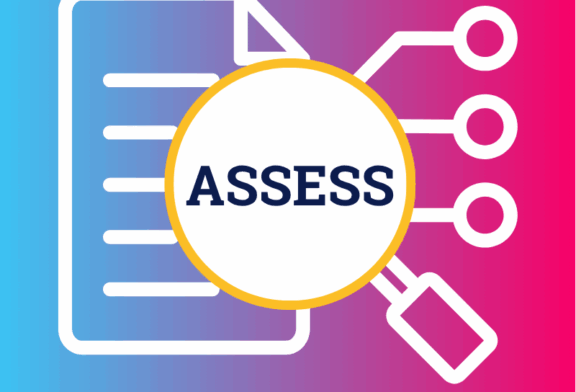There are a number of performance management issues that can derail progress. They cost you, a busy HR leader, time and money.
Pressure to improve company performance is mounting.
And you’re against the clock. Rising costs and economic fears require high-performing organisations that deliver reliable revenue.
There’s no time for your team to stagnate or underperform.
Every day, you spend hours firefighting – juggling paperwork, attending countless meetings, and wrestling with unwieldy spreadsheets.
Driving better results is difficult. And you don’t have time to fix the many roadblocks to effective performance management.
Understanding Performance Management
Being a routine process, Performance Management helps employees align their goals with those of the company. With a proper Performance Management Process, it becomes easier to achieve the below goals:
- Set priorities, and targets, that can be observed in real time
- Track performance
- An effective feedback and appraisal process
- Rewarding employees when targets are reached
- Helps cultivate the skills that are needed
When talking about companies, the performance management process can help with the following:
- Creating a team with a common goal
- Fewer employees leaving the company
- Increasing the number of targets reached
- Improve communication between workers and their seniors.
Engaging and driving high-performance employees seems impossible.

Performance management is a powerful process that companies can use to boost productivity, profitability and engagement.
But when you don’t implement performance management correctly, problems can arise.
And they can affect your bottom line.
5 Common Issues and Challenges of Performance Management
The most common challenges of performance management we hear are:
1. Time limitations restricting performance management improvements
Traditional performance management systems are very manual, paper-based and time-consuming.
You may have no idea how much time you need to spend fixing performance management challenges. But you know it’s not a quick fix.
The answer lies in a centralised, holistic employee performance management strategy.
2. Limited employee buy-in to performance management approaches
If you’re frustrated by low engagement with your performance management initiatives, you’re not alone.
It’s a common challenge we hear from people leaders across a wide range of industries.
And getting employees on-board seems impossible.
What you need are performance management techniques built on a strong foundation of positive employee experience and development.
3. Access to employee data and insights is limited
You need real-time, accurate employee data to deliver effective performance management.
Yet, like many leaders, you have limited access to these key insights. And what you can access is inaccurate or outdated.
The solution? An employee performance management strategy that collects key data, automatically.
4. Ineffective goal setting and unclear feedback
It may happen that the goals set as an employee’s target for a work quarter are subjective. As a result, these cannot be defined as a set of data, giving rise to ambiguities. When providing feedback for such data, it can so happen that objectives used to assess targets might not match.
Wondering how to solve this? Use quantifiable targets. When the targets are in the form of set data and numbers, neither the employee nor the manager can dispute them.
Similarly, the feedback provided needs to be relatable, concise, and useful. For instance, feedback given should have the following:
- Specifics
- Focus on the work delivered
- Definite steps that can be taken
The recipient, work assigned, and the format used should also be kept in mind during both goal setting and the feedback process.
5. Inappropriate leadership styles and lack of strategic planning
Not all goals set and plans implemented are quantified and in line with company goals. When leaders dictate instead of leading, employee engagement is reduced, work-life balance gets hampered, and turnover may increase.
The best results are obtained when people lead by example. Further, it is the duty of those in a leadership position to effectively motivate employees, have flexibility, and provide clear communication.
To add to this, strategic planning is essential when it comes to driving a company’s goals.

How This Post Will Help You Improve Employee Performance
We spend a lot of time helping leaders like you to solve their performance management issues.
And we’ve seen it all.
Low productivity. Increasing employee turnover. Performance decreasing.
In this post, we’ll discuss how we help people leaders to overcome their performance management issues, and show what makes StaffCircle the best employee success platform for performance-driven organisations.
Five Strategies to Solve Your Performance Management Issues
If you resonate with the challenges above, you’re in the right place.
Each of these five strategies work together to help you build a high-performing workforce. Plus, each of them work in harmony to help you overcome your performance management issues.
1. Improve your performance management structure
The issue: You have an inconsistent performance management process.
Reviews aren’t scheduled regularly. You rely on managers to book performance reviews. Employees don’t receive regular feedback, and are unclear on their goals.
It’s a recipe for disengagement and a barrier to high performance.
The solution: Automated software that makes consistent performance management a breeze.
Use Objectives and Key Results (OKRs) and Key Performance Indicators (KPIs)
A failure to set clear goals leads to employees who lack focus and direction.
Clear goals give employees something to aim towards. A direction for their productivity. A clear target for performance.
StaffCircle’s performance management tools overcome problems associated with goals and expectations.
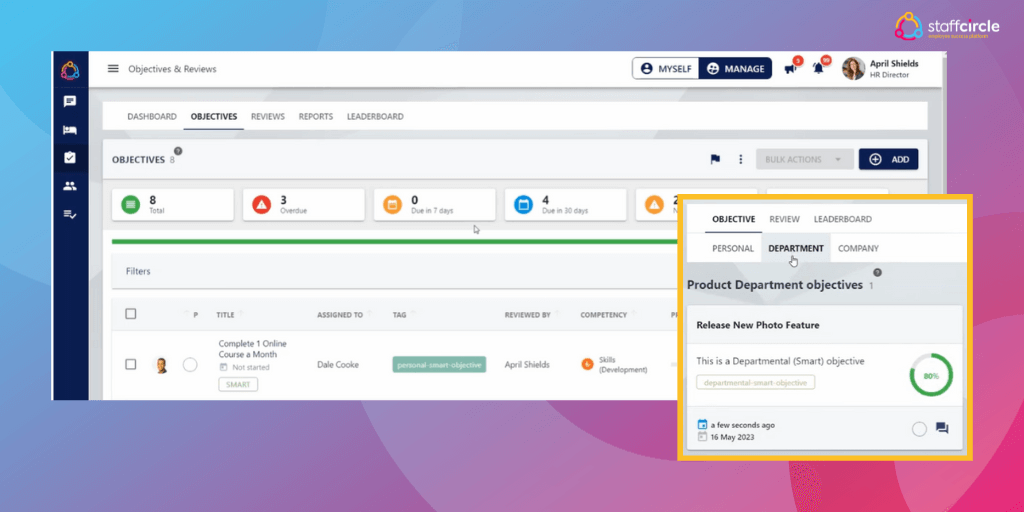
Create OKRs, link them to departmental and company goals. Create personal or shared objectives, and allow employees to view, track and update their own progress.
Give your managers a birds-eye view of employee performance, at a glance.
Use performance management tools to automate reviews
Drive better performance by introducing structured and on-demand reviews that build consistency and a supportive culture.
Annual reviews are a thing of the past. Regular performance development conversations are required to drive productivity and success.
With StaffCircle, streamline performance with automated reviews.
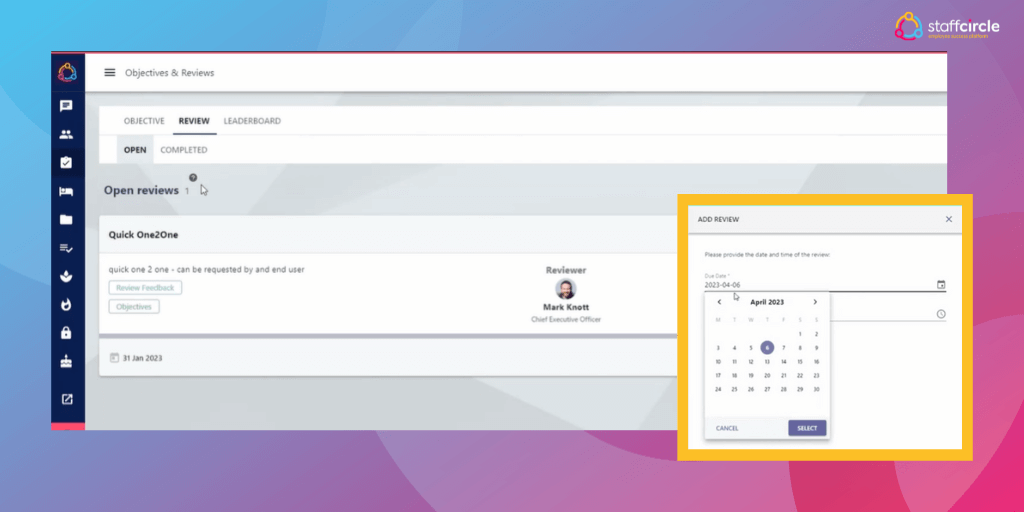
2. Understand workforce performance with real-time data
Real-time employee data is vital for effective performance management.
Yet most leaders have limited access to these key insights.
The majority rely on manual spreadsheets. Over a fifth juggle siloed reporting streams. Worryingly, nearly 10% work with no employee data at all.
Sound familiar?
60% of HR leaders spend over one week accessing data on employee performance. And the data they end up using is static, outdated and inaccurate.
How can you access the insights you need to succeed?
The solution: StaffCircle’s all-in-one platform that drives better performance.
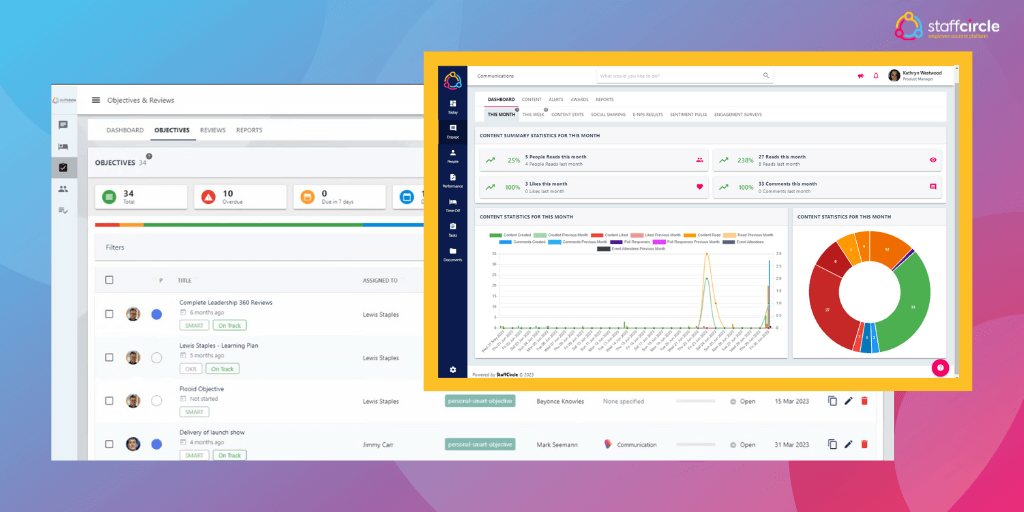
StaffCircle combines the tools you need to drive performance management with real-time, actionable insights.
Experience enhanced performance ratings driven by automated processes, access dedicated engagement tools, and craft detailed development plans—all evidenced by employee data that’s collected instantly.
Focus on what matters, from one single platform:
- Embed results-driven goals and feedback to help teams deliver
- Accurately report on employee productivity, satisfaction and culture
- Develop and retain top talent with individual skills and success plans
Step away from knee-jerk decisions. Use real-time data to plan, implement and measure every initiative.
A single source of truth. Visibility of what really matters. One place for all people strategy.
We polled leaders who use StaffCircle to drive performance management. And the benefits of using our performance management software are clear to see:
- Almost two thirds report improved future planning and strategic decision-making
- 93% are confident in the accuracy of employee data
- Over 75% can access accurate employee data in one day or less
- 64% find it easier to retain their top talent
Don’t let ineffective performance management be the roadblock to your success. Discover StaffCircle.

3. Make performance management objective
The issue: Your performance management data is subject to bias or inaccuracies.
There are thousands of untracked interactions in your employee’s daily actions.
The insights that you do have access to are often hard to find.
Hidden in spreadsheets. Reliant on subjective, anecdotal opinion. Siloed in pen-and-paper storage systems.
If you solely rely on the below data points to measure the results of your people strategy, you could be making crucial decisions on subjective, biased data:
- Retention rate
- Absence rate
- eNPS score
- Annual survey results
- Employee appraisal feedback
The solution: Unbiased performance management insights, collected automatically.
While the traditional performance metrics are useful to track, they don’t give an unbiased insight into true performance sentiment.
They each provide limited windows into different aspects of performance.
You can’t track, improve and analyse performance holistically.
You can’t honestly know if performance management issues are due to lack of progression, employee burnout or misaligned leadership.
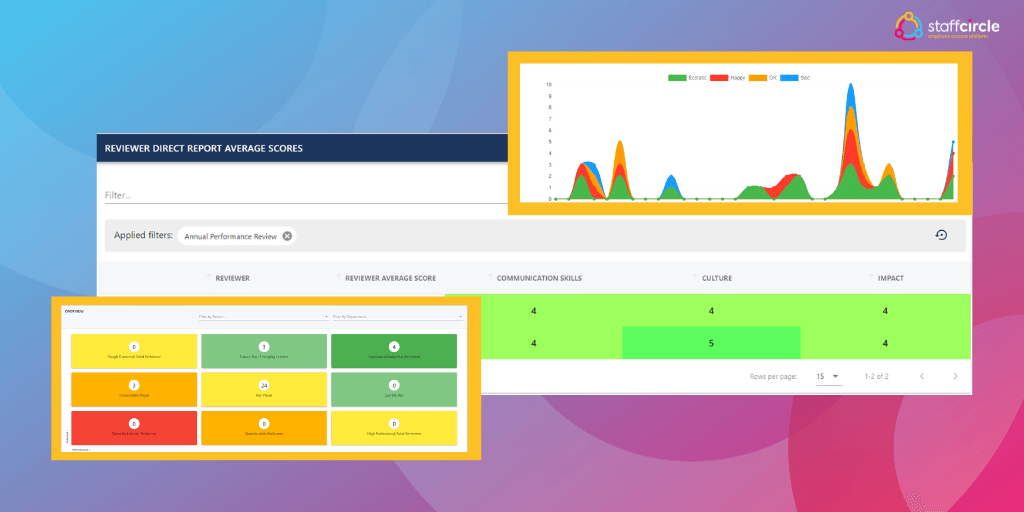
All you know is that performance is stagnating, and your initiatives aren’t working.
The key is to focus on employee signals, not surveys.
Employee signals are real-time, unbiased insights into workforce sentiment.
Metrics that are gathered from every single interaction: their performance, their engagement and their development.
Effective performance management harnesses this data to build a detailed picture of the evolution of your workforce.
Objective data allows you to make informed decisions, spot potential setbacks and plan performance management strategically.
4. Master effective feedback tips
The issue: Your employees don’t receive consistent, relevant feedback on performance.
Your employees don’t receive enough feedback to help them improve performance.
We found that the majority of employees would consider leaving an organisation if they didn’t receive frequent managerial feedback and communication. This increases to 73% for Gen Z employees.
However, most employees only check-in with their manager once a month, or less.
And they don’t receive the feedback they need to perform at their best.
The solution: Performance management software with trackable feedback mechanisms that supports leaders, managers and employees.
Frequent feedback and reviews help to build consistency and a culture of stability for employees, in addition to opening up communication between the company and its employees.
However, regular ongoing feedback improves communication and employee satisfaction.
It helps your team understand their performance, creates security and boosts loyalty.
In fact, companies that use continuous employee feedback strategies can reduce turnover by 14.9%.
And yet businesses still don’t see continuous feedback practices as a priority. According to our 2022 study, less than 50% of organisations offer regular feedback to their employees.
Amongst all generations, millennials were the employees most driven by regular feedback.
And with millennials making up the majority of global workforces, providing the feedback they crave is key.
However, a quick ‘great job’ as verbal feedback doesn’t provide people leaders with actionable data.
It can’t be traced, collated and analysed to gain a true understanding of performance.
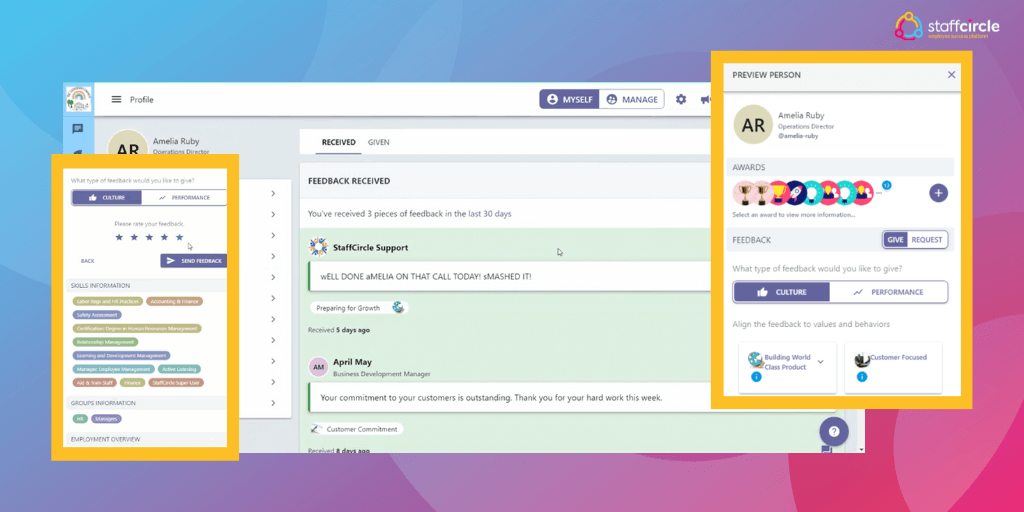
Instead, an effective people strategy involves regular documentation and review of 360 feedback.
This includes collating real-time feedback from: Continuously collecting, reviewing and discussing layered employee feedback types allows you to build a true picture of performance.
It gives you the power of data.
How does your workforce view their peers? Who’s performing well, but could be better suited for a leadership position? Are there any employees that could use further performance support?
Real-time, unbiased opinion of how your employees collaborate. Priceless information that drives performance management.
Using a multi-channel communications platform
Gen Z employees in particular want to ‘see companies passionately uphold their principles and stand by what they advocate’.
This starts with simply getting better at communicating with your employees.
The effects of poor communication are varied.
Employees can lack an understanding of expectations, leading to negativity and poor performance. Lack of trust, absence and sickness, and low morale will follow.
Multi-channel communications give businesses the framework for a consistent communications strategy.
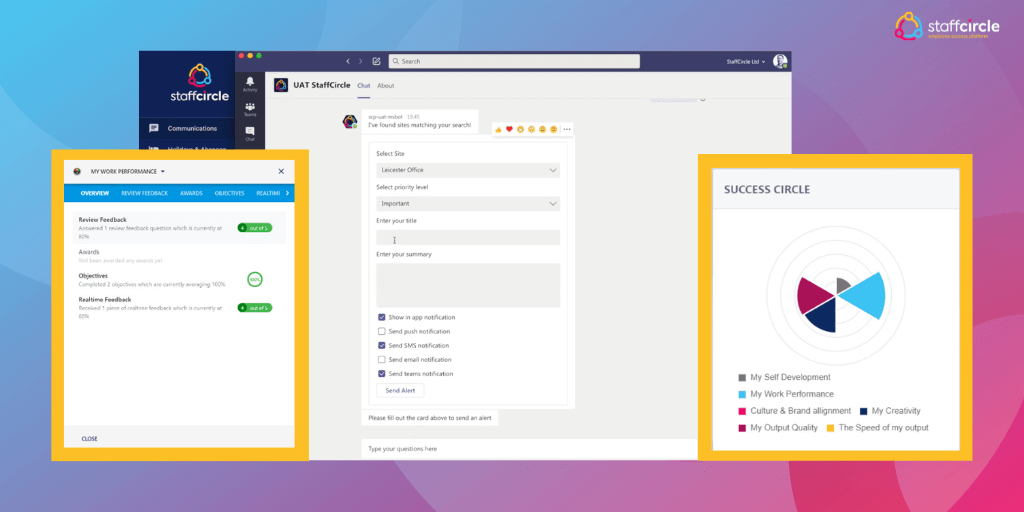
Rather than focusing comms in one direction, they allow for the flow of information across platforms including emails, SMS, and in-app push notifications.
This is crucial if your organisation has adopted a hybrid work model, with remote workers and other off-site employees collaborating with staff based in the office.
With a multi-channel communications platform in place, you can:
- Create more opportunities for dialogue
- Implement steps to confirm messages have been read and understood
- Reach employees wherever they’re working, including via phones if they’re on the road
- Personalise communications to bring them in line with company culture
- Gather data into the effectiveness of the communications strategy
- Set priorities and alerts for urgent messages
Additional Read: Check Out Our Mobile App
5. Implement individual professional development plans
The issue: Your employees don’t understand what they need to achieve to progress.
How do you help your team to upskill and grow?
It’s a vital part of performance management. Yet nurturing future development is often omitted from performance management plans.
94% of employees would stay in a role for longer if their organisation offered learning and development opportunities.
The solution: personalised development plans that encourage a culture of constant growth.
High-performing employees don’t want to stagnate.
To encourage a culture of constant development, you need to give your workforce control over their own growth.
Motivate your team with a hands-on approach to their own career progression. Give every manager the ability to nurture a successful team. Validate your people strategy with real-time data.
Personal development is a key factor in improving performance.
Treating personal and professional development similarly to performance is a unique strategy that demonstrates your commitment to progression.
Collaboratively defining individual development objectives gives employees the motivation and confidence to grow.
Whether that be learning a new skill, expanding their project horizons or simply giving them the space to boost their knowledge through podcasts or articles.
Documenting, reviewing and tracking these objectives keeps employee development front of mind.
Data is the foundation of understanding any skills gaps and finding the best candidates to fill them.
It allows for better people management. Informed project scoping. More productive teams.
With tracked progression of skills built into StaffCircle, you can assess competency levels on an individual, team and business level.
In realtime, at a glance.
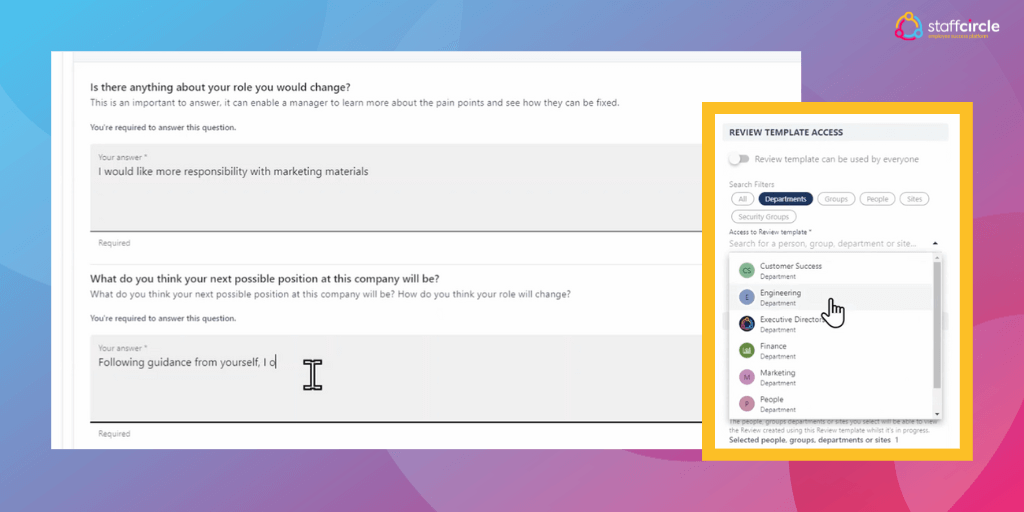
StaffCircle customers can use our proven employee development templates.
They provide structure to progression plans, documenting the effort taken to grow.
Structuring employee development creates better teams. Ambitious teams that aren’t afraid to upskill, to try new things and form ever-evolving workforce abilities.
They highlight rising stars and nurture them to better performance.
Additional Read: What is a Performance Management System?
How to Solve Your Performance Management Issues
StaffCircle’s performance management system is the key to resolving your performance issues.
Tried and trusted by hundreds of business leaders with the same frustrations as you. The reviews are in, and StaffCircle is proven to improve your performance management process.
In summary, we believe that a combination of five strategies will improve your performance effectiveness:
- Improving your performance management structure
- Understand workforce performance with real-time data
- Make your performance management process objective
- Mastering effective ongoing feedback techniques
- Implement individual professional development plans
And you can implement them all, at the same time, by using StaffCircle.
Why Performance Management Software is Vital
It sounds like a people leader’s dream. A wealth of real-time employee performance data, generated by tried-and-tested strategies.
But with a performance management platform, it becomes a reality.
Of course, the strategies outlined in this guide can be carried out manually. You can introduce the core theories, carry them out and analyse the results using traditional pen-and-paper methods.
But it’ll take time. Vital hours of your busy schedule, creating documents, chasing managers and collecting data.
If it were simple, you wouldn’t have performance management issues. You wouldn’t be concerned about employee retention, engagement or development.
StaffCircle’s drives your performance management strategy.
Additional Read: All-in-one Performance Management Software
Request a demo of StaffCircle
For more information on how StaffCircle works, and the best ways you can leverage our performance management software, click below to request a 1-on-1 demo with our experts.




